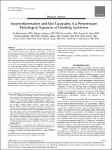Neuroinflammation and Not Tauopathy Is a Predominant Pathological Signature of Nodding Syndrome

View/
Date
2019Author
Hotterbeekx, An
Lammens, Martin
Idro, Richard
Akun, Pamela R.
Lukande, Robert
Akena, Geoffrey
Nath, Avindra
Taylor, Jonee
Olwa, Francis
Kumar-Singh, Samir
Colebunders, Robert
Metadata
Show full item recordAbstract
Nodding syndrome (NS) is an epileptic disorder occurring in chil dren in African onchocerciasis endemic regions. Here, we describe
the pathological changes in 9 individuals from northern Uganda who
died with NS (n ¼ 5) or other forms of onchocerciasis-associated ep ilepsy (OAE) (n ¼ 4). Postmortem examinations were performed
and clinical information was obtained. Formalin-fixed brain samples
were stained by hematoxylin and eosin and immunohistochemistry
was used to stain astrocytes (GFAP), macrophages (CD68), ubiqui tin, a-synuclein, p62, TDP-43, amyloid b, and tau (AT8). The cere bellum showed atrophy and loss of Purkinje cells with hyperplasia
of the Bergmann glia. Gliosis and features of past ventriculitis and/
or meningitis were observed in all but 1 participant. CD68-positive
macrophage clusters were observed in all cases in various degrees.
Immunohistochemistry for amyloid b, a-synuclein, or TDP-43 was
negative. Mild to sparse AT8-positive neurofibrillary tangle-like
structures and threads were observed in 4/5 NS and 2/4 OAE cases,
preferentially in the frontal and parietal cortex, thalamic- and hypo thalamic regions, mesencephalon and corpus callosum. Persons who
died with NS and other forms of OAE presented similar pathological
changes but no generalized tauopathy, suggesting that NS and other
forms of OAE are different clinical presentations of a same disease
with a common etiology.
Key Words: Epilepsy, Nodding syndrome, Onchocerciasis, Post-mortem, Uganda.
